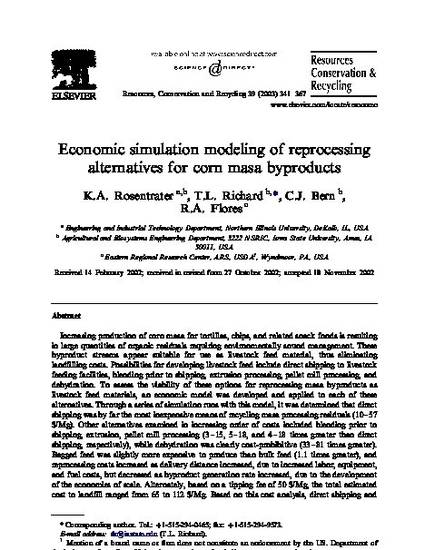
Increasing production of corn masa for tortillas, chips, and related snack foods is resulting in large quantities of organic residuals requiring environmentally sound management. These byproduct streams appear suitable for use as livestock feed material, thus eliminating landfilling costs. Possibilities for developing livestock feed include direct shipping to livestock feeding facilities, blending prior to shipping, extrusion processing, pellet mill processing, and dehydration. To assess the viability of these options for reprocessing masa byproducts as livestock feed materials, an economic model was developed and applied to each of these alternatives. Through a series of simulation runs with this model, it was determined that direct shipping was by far the most inexpensive means of recycling masa processing residuals (10–57 $/Mg). Other alternatives examined in increasing order of costs included blending prior to shipping, extrusion, pellet mill processing (3–15, 5–18, and 4–18 times greater than direct shipping, respectively), while dehydration was clearly cost-prohibitive (33–81 times greater). Bagged feed was slightly more expensive to produce than bulk feed (1.1 times greater), and reprocessing costs increased as delivery distance increased, due to increased labor, equipment, and fuel costs, but decreased as byproduct generation rate increased, due to the development of the economies of scale. Alternately, based on a tipping fee of 50 $/Mg, the total estimated cost to landfill ranged from 65 to 112 $/Mg. Based on this cost analysis, direct shipping and feeding to livestock is the recycling option of choice for masa processing byproducts. Although specific details of process configurations and associated costs will vary, similar results are likely for other high moisture food processing residuals destined for utilization as livestock feed or components thereof.
Available at: http://works.bepress.com/cjbern/3/

This article is from Resources, Conservation and Recycling 39, no. 4 (2003): 341–367, doi:10.1016/S0921-3449(02)00175-1.